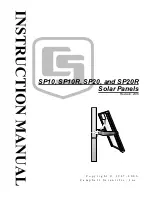
Solarion
M210P
EN V1.0 2015-10-20 © OC3 AG
Figure 3: Welding multiple solar panels on to roofing membrane or other membrane surface
Multiple solar panels can be connected in series and parallel to reach desired power generation.
As accepted good practice, the following installation recommendations should be abided by:
•
The solar modules should be welded to each other by their neighbouring edges as shown in Figure 3.
•
There must be 150 mm of distance between glass edges of solar panels
•
In a group of solar modules there space between horizontal groups must be at least 150 mm
•
Use Solarion M210P series module for PVC based polymeric installation surface.
This is crucial for
proper welding of the solar
module on to installation membrane.
Electrical Installation
Modules of the same type (i.e. Solarion M230 KEE) and power class (i.e. 235 Watt) must be used within a serially-
connected module string. A Multicontact junction box is glued to the front side of the module on to membrane backing. Removing
the junction box from the membrane, or opening the junction box will void the module guarantee. The male and
female connectors are labeled with “+” and “-“, respectively. Same-type connectors must be used in the interconnection of Solarion solar
modules. All cables used in the solar system must be appropriate for long-term outdoor use (i.e. UV-resistant) The insulation rating of the
cable must be equal to or greater than the highest expected open circuit voltage (Voc) Please observe all local regulations, such as
building and electrical codes, in your region. In order to avoid damage to the cables, do not lay the cables on sharp edges, and it is
strongly recommended to use cable ties on the cables such that they are not able to sit in standing or run-off water. The cable cross
sections for module interconnections must abide by standard practice with professional standards.
Under certain circumstances, Solarion modules may generate more current or higher voltage as the current and voltage measured at
standard test conditions (STC is defined as an irradiance of 1000 W/m2 at 25°C). It is therefore important to use a minimum safety factor
of 1.25 when specifying string fuses, string diodes, cables and inverters. The maximum system voltage found on the module labels must
not be exceeded.
The use of additional system components such as fault detectors (e.g. RCD, GFDI, etc.), fuses, diodes or circuit breakers may be required
due to local electrical or safety ordnances. Thus safety regulations of these components must likewise be met. Since the glass-membrane
solar panels do not have any accessible conductive parts (i.e. frame), they need not be electrically grounded. Please be aware that
local regulations and codes for functional grounding or substructure bonding of solar systems shall prevail.
Each module string requires the use of serially-connected string diodes in order to avoid the flow of reverse current
from parallel strings or from defective inverters. It is recommended to use rectifier diodes with blocking voltages in accordance
with the appropriate system voltage. The use of string fuses is not mandatory.
For a system voltage of 1000 Volt, a maximum 32 modules are allowed to be serially connected in a single module
string. Based on the aforementioned requirements for the use of string diodes, there is no limit to the number of
strings wired in parallel.
Operation and Maintenance
OC3 AG recommends that a specialist perform any possible required maintenance of your solar system. Routine
maintenance is not necessary; however, it is recommended that the solar system be checked at least once per year for damage, soiling,
etc. Defective modules must be taken out of operation and immediately replaced. Soiling (i.e. pollen, vegetation, bird lime, etc.)
on the front side of the module can be removed with a damp sponge or cotton cloth at ambient temperatures between 10°C and
30°C. De-mineralized water (i.e. soft water) should be used to avoid water stains. Under no circumstances should
abrasive detergents or soaps (i.e. surfactants) be used!
Module Disposal
Module disposal must be done in agreement with local ordinances. The end customer is therefore responsible to correctly dispose of the
modules. If you have any questions on this matter, please contact OC3 AG, and we will consult on proper methods of disposal.























